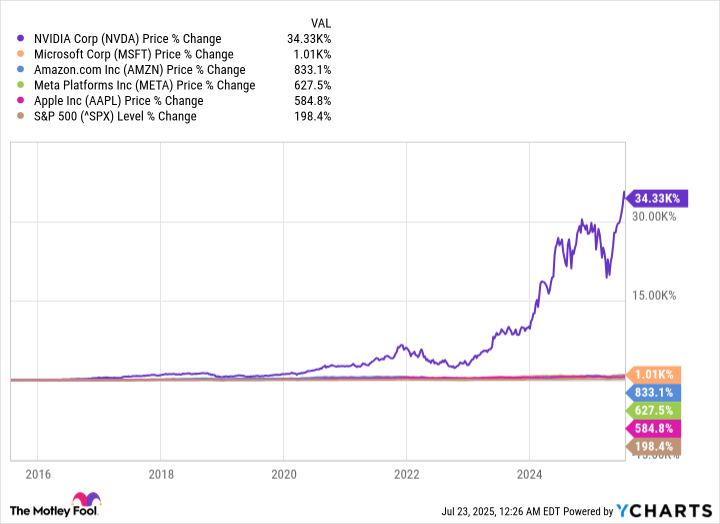The S&P 500 is among the leading U.S. stock market indexes. It's home to 500 companies from 11 different sectors of the economy, and they have to meet very strict criteria before a special committee can grant them entry. This process ensures that only the highest-quality names make the cut.
The S&P 500 has delivered a compound annual return of 10.5% (including dividends) since it was established in 1957, even after accounting for every sell-off, correction, and bear market along the way. Its steady returns and diverse composition are two key reasons experts, such as Warren Buffett, regularly encourage everyday investors to buy an S&P 500 index fund.
But younger investors who have time on their side or those with a greater appetite for risk in general may want to explore other options with higher growth potential. After all, even a couple of extra percentage points per year can translate into life-changing amounts of money over a period of decades.
Here are two high-growth Vanguard exchange-traded funds (ETFs) to consider.

1. The Vanguard Growth ETF
The Vanguard Growth ETF (VUG +0.59%) aims to track the performance of the CRSP US Large Cap Growth Index, which invests in the companies that make up 85% of the cumulative market capitalization of the CRSP US Total Market Index. That sounds complicated, but let me explain.
The CRSP US Total Market Index holds all 3,537 companies listed on American stock exchanges. If we ranked them by market capitalization (value) from the largest to the smallest, the CRSP US Large Cap Growth Index would start at the very top and invest in every single name down the list until it captures 85% of the combined value of the 3,537 companies.
The Vanguard Growth ETF holds only 165 stocks, which highlights the extreme concentration of wealth in the American corporate sector. In other words, 165 companies represent 85% of the total value of the entire stock market, while the remaining 3,372 companies account for the other 15%.
The Vanguard ETF itself is also highly concentrated. Its top five holdings represent 44.2% of the value of its entire portfolio:
|
Stock |
Vanguard Growth ETF Portfolio Weighting |
|---|---|
|
1. Microsoft |
11.76% |
|
2. Nvidia |
11.63% |
|
3. Apple |
9.71% |
|
4. Amazon |
6.53% |
|
5. Meta Platforms |
4.57% |
Data source: Vanguard. Portfolio weightings are accurate as of June 30, 2025, and are subject to change. ETF = exchange-traded fund.
Those same five stocks represent just 26.9% of the value of the S&P 500. That difference in weighting is very important because over the last 10 years, for example, those stocks have delivered a median return of 833%.
Simply put, any index or fund with a high exposure to those five stocks alone over the past decade probably outperformed the S&P 500. Unsurprisingly, the Vanguard ETF generated a compound annual return of 16.2% over the last 10 years, compared to just 12.8% for the S&P 500.
Going back even further, the ETF has risen at a compound annual rate of 11.8% since it was established in 2004, beating the S&P, which has delivered an average annual return of 10.1% over the same period. That 1.7 percentage point difference might not sound like much at face value, but it would have made a big difference in dollar terms.
|
Starting Balance (2004) |
Compound Annual Return |
Current Balance (2025) |
|---|---|---|
|
$50,000 |
11.8% (Vanguard ETF) |
$520,292 |
|
$50,000 |
10.1% (S&P 500) |
$377,140 |
Calculations by author.

NYSEMKT: VUG
Key Data Points
2. The Vanguard Mega Cap Growth ETF
The Vanguard Mega Cap Growth ETF (MGK +0.28%) offers even higher exposure to tech titans and artificial intelligence (AI) giants such as Nvidia and Microsoft. It tracks the performance of the CRSP US Mega Cap Growth Index, which invests in the companies that make up 70% of the cumulative market cap of the CRSP US Total Market Index.
If we revisit my earlier example, the CRSP US Mega Cap Growth Index would start investing in the largest stocks and go down the list until it captures 70% of the total value of the 3,537 companies in the CRSP US Total Market Index.
As a result, the Vanguard Mega Cap Growth ETF holds just 69 stocks, so each name organically receives an even higher weighting than it would in the Vanguard Growth ETF. In fact, its top five holdings represent a whopping 50.3% of the value of its portfolio:
|
Stock |
Vanguard Mega Cap ETF Portfolio Weighting |
|---|---|
|
1. Microsoft |
13.49% |
|
2. Nvidia |
13.34% |
|
3. Apple |
11.14% |
|
4. Amazon |
7.52% |
|
5. Broadcom |
4.81% |
Data source: Vanguard. Portfolio weightings are accurate as of June 30, 2025, and are subject to change. ETF = exchange-traded fund.
The Vanguard Mega Cap Growth ETF has delivered a compound annual return of 13.4% since its inception in 2007, comfortably beating the S&P 500, which generated an average return of 10.2% per year over the same period. Over the past decade, specifically, the ETF grew at a blistering annual rate of 17%.
|
Starting Balance (2007) |
Compound Annual Return |
Current Balance (2025) |
|---|---|---|
|
$50,000 |
13.4% (Vanguard ETF) |
$480,844 |
|
$50,000 |
10.2% (S&P 500) |
$287,235 |
Calculations by author. ETF = exchange-traded fund.
A few things to keep in mind
The technology sector has a weighting of 60.4% in the Vanguard Growth ETF and 63.9% in the Vanguard Mega Cap Growth ETF. While this high degree of concentration has clearly led to incredible returns, it also leaves investors exposed to significant risks.
If stocks like Nvidia and Microsoft were to suffer steep corrections, both ETFs would likely underperform the S&P 500 for a period of time. Moreover, if emerging technologies, such as AI, robotics, and machine learning, fail to live up to expectations, a much broader group of stocks will be affected, which could trigger a more prolonged period of weakness for these Vanguard ETFs.

NYSEMKT: MGK
Key Data Points
Therefore, investors should buy these ETFs only as part of a diversified portfolio that includes other funds and individual stocks. This strategy could still lead to much better returns than investing in an S&P 500 index fund alone, but it will also provide some insulation if high-growth themes like AI suffer a setback.
